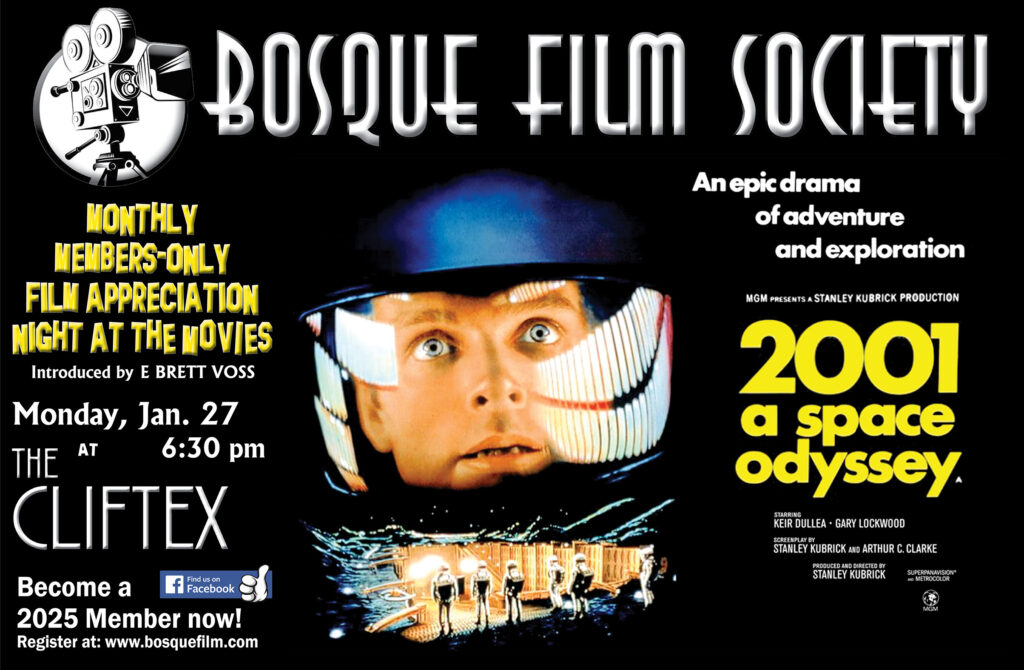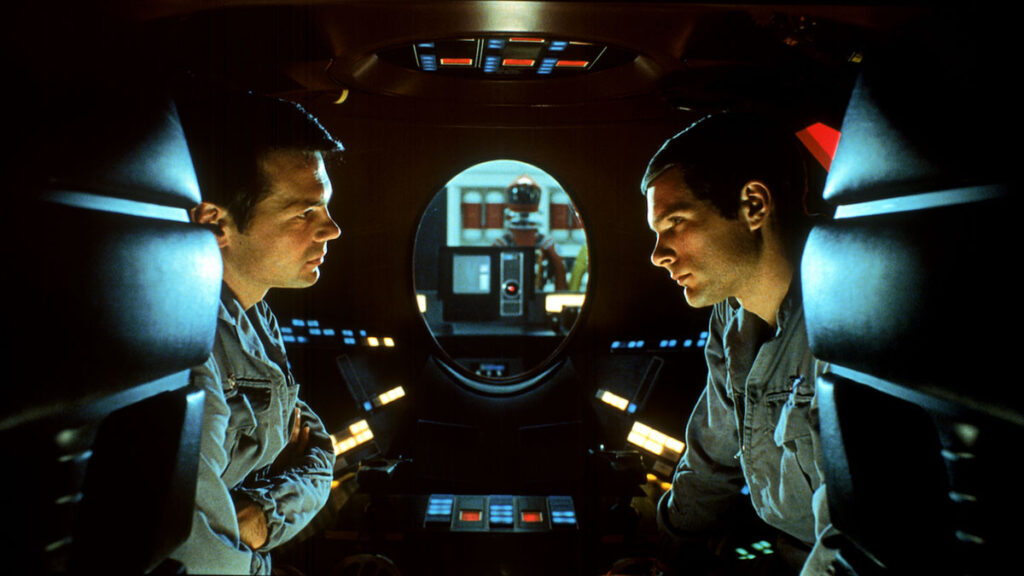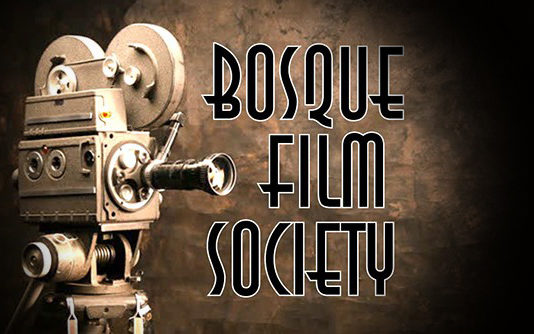Experience the vast void of space with Stanley Kubrick’s groundbreaking “2001: A Space Odyssey” on the silver screen at the historic Cliftex Theatre in Clifton
By E. BRETT VOSS
Bosque Film Society Founder & Board President
“Open the pod bay doors, Hal.” “I’m sorry, Dave. I’m afraid I can’t do that.”
From the very beginning of motion pictures in 1895, filmmakers have been fascinated by science fiction stories. In fact, the first science fiction film was produced during the dawn of filmmaking, “A Trip to the Moon” in 1902.
In the 1930s, the Buck Rogers comic book character and related film serial launched the science fiction genre into social relevance. By the 1950s, science fiction produced a slew of successful films, such as The Day the Earth Stood Still (1951), The Thing from Another World (1951), Forbidden Planet (1956), Invasion of the Body Snatchers (1956), and Journey to the Center of the Earth (1959).
It’s important to note that until the early 1960s, space travel and the subject of most science fiction films remained nothing more than a fantasy and a figment of a particular writer’s imagination. But then, President John F. Kennedy launched the U.S space program’s race with the U.S.S.R. with his famous 1961 speech, stating “I believe that this nation should commit itself to achieving the goal, before this decade is out, or landing a man on the moon and returning his safely to Earth.”
 With that, space travel became a reality, happening live before our eyes in our very own living rooms through fuzzy black and white broadcasts. But when the astronauts returned from their missions, they brought home pristine color photography of the experience in outer space.
With that, space travel became a reality, happening live before our eyes in our very own living rooms through fuzzy black and white broadcasts. But when the astronauts returned from their missions, they brought home pristine color photography of the experience in outer space.
With space travel now a reality we had all seen firsthand, the burden of recreating that realism in a believable manner fell of the filmmaker wanting to venture into the science fiction genre moving forward. The importance and influence of Stanley Kubrick’s “2001: A Space Odyssey,” released a year before Apollo 11 landed on the moon, cannot be overstated or even overestimated. Quite simply put, no other film that has had that level of impact and inspiration on subsequent generations of filmmakers and the art of filmmaking.
Yet for many modern film viewers, the film can be perceived as dull, opaque, unfathomable and pretentious — with minimal dialogue and its hauntingly beautiful classical music score. To this day, almost 60 years later, the film can still be misunderstood altogether. In fact, when 2001: A Space Odyssey debuted in 1968, it was ridiculed by many film critics. And at premiere screenings, audiences even booed and walked out of theaters. In fact, a very young Roger Ebert stood out as one of the very few film critics of the time that sang praises for the film.
But despite this initial reaction, audiences still lined up to see the movie. 2001: A Space Odyssey became not just a commercial success, but a popular phenomenon with the younger generation of movie-goers in the 1960s. Partially fueled by the drug and counter-culture of the time — 2001 was ultimately accepted in the way Kubrick had intended — people went to “experience” the film.
Instead of being told a clear, specific story with conflicts and resolutions, 2001 presented the audience with a grand mythological journey — from the origins of humans to their technological future and beyond. And it did so by abandoning the conventions of storytelling and asking the viewer to simply absorb the sights and sounds of the film and allow themselves to have an instinctual, emotional response.
 With 2001: A Space Odyssey, Kubrick and renowned science fiction writer Arthur C. Clarke created a meta-narrative — a story concerning the very nature of existence, proposing a secular solution to the mystery of life, addressing the questions: “How did we get here?” and “Are we alone?”
With 2001: A Space Odyssey, Kubrick and renowned science fiction writer Arthur C. Clarke created a meta-narrative — a story concerning the very nature of existence, proposing a secular solution to the mystery of life, addressing the questions: “How did we get here?” and “Are we alone?”
With the screenplay based on two short stories by Clarke, Kubrick was drawn to a short story that suggested an advanced alien race travels the universe looking for nascent intelligence and then once discovered, helps it along in critical next steps steps of cognitive abilities. Just enough to see if the formative intelligence becomes capable of developing technology that allows that to start traveling their local solar system and exploring their origins. The aliens leave a buried artifact on the closest nearby moon that — when uncovered — signals to the aliens that — yes indeed — this group of intelligence has made the leap — and are now possibly ready for the next step in evolution.
Kubrick felt that trying to tell this story in an ordinary fashion with dialogue and conversations might come off as pretentious, draining the mystical and magical quality he felt the film needed. He knew he had to get the audience to experience such moments of alien contact and alien manipulation of the human mind in way that felt like an experience observed— a personal, magical and spiritual experience — not a dramatic one.
What Kubrick was seeking was much closer to the experience one has when walking quietly through a massive cathedral — one of the grand medieval cathedrals of Europe — where the person is overwhelmed by the stunning beauty, grandiosity and silence of the cathedral — Kubrick knew he needed the viewer to experience space in this manner.
And that’s why the movie seems slow to many modern, younger viewers. Kubrick needed you to sit in the cathedral of space — and in the stark beautiful technology of 2001 — in order for you to absorb the reality of the mind-bending spiritual myth he was laying on you.
To fully accomplish this effect, Kubrick needed the viewer to settle into the elongated time-scape of space travel. Why? Because it’s vital the viewer experience the space mission in a way that gets them to fully believe in what’s happening. To get them to accept what they are watching is real. So that the viewer stops thinking they’re watching a movie.
 So, Kubrick had to make the space travel experience just as real — if not more so — than what we had already seen live on television.
So, Kubrick had to make the space travel experience just as real — if not more so — than what we had already seen live on television.
With that said, it’s nearly impossible to explain to today’s movie-goer how far advanced the effects of 2001 were at their time. Today’s films have the advantage of powerful computers to easily create seamless special effects of almost type. But back in 1966-67 there were no computer—generated effects. No CGI. It was all created on film. Analogue film. Multiple shots on differed strips of films are combined in an optical printer to look like they are all in one shot. Think of it as artistically hand-crafted special effects.
Same with the interior sets. All real. All painstakingly built by hand. Many of them rotated. The giant centrifuge set for the Discovery space craft was a massive Ferris wheel with cameras and actor bolted to floor while it turns.
In the sequence “The Dawn of Man,” man-apes were created with costume designs that were decades ahead of their time — all donned by a mime troupe that spent months studying real ape movements. The effect was so convincing that many people simply assumed real apes had been trained to “act out” the scenes. To the point where make-up and costume designer Stuart Freeborn’s amazing accomplishment was completely overlooked by the Academy awards — giving best make-up effects instead to the much more primitive and unconvincing “Planet of the Apes.”
Make no mistake about it…2001: A Space Odyssey is by no means a consumable flight of fancy film the likes of Star Trek and Star Wars. As pretentious as this may sound — 2001 is undeniably a work of art. It’s meant to challenge the viewer, to stimulate your senses and create an instinctive impression. It’s not meant to be easily understood, it’s much bigger than that. It is a film that was made to present a mythology of how humanity came into existence. It’s meant to be an experience.
Make no mistake about it…2001: A Space Odyssey transcends the normal, expected night at the movies for all of us. For those of you new to this film, tonight, you are about to embark on a cinematic experience the likes of which you have never seen before. And for those of you who have not seen it on the big screen for years, you are about to revisit your first contact with an encounter of an enlightening kind. So, sit back and enjoy the experience.
